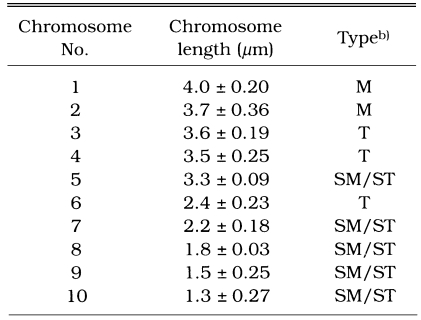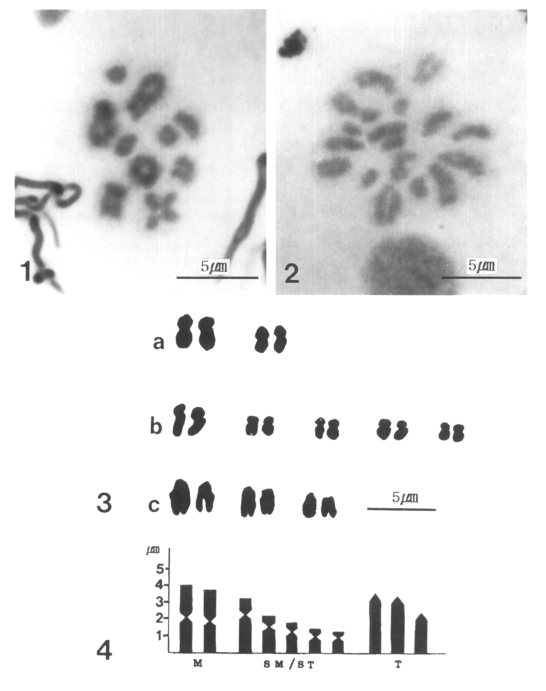Abstract
A karyotype analysis of the chromosome of Neodiplostomum seoulense, one of causative agents of human intestinal trematodiasis, was done from the gonad tissue by the squashing method. The chromosome number was n = 10 and 2n = 20. Chromosome length was 1.30-4.0 µm. Chromosome pairs in the complement consisted of two pairs of metacentric, five pairs of submetacentrics/subtelocentric and three pairs of telocentric chromosomes. These data were comparable with those of other intestinal trematodes.
Keywords: Neodiplostomum seoulense, karyotype, chromosome, trematoda
Neodiplostomum seoulense (Trematoda: Neodiplostomatidae) is one of causative agents of human intestinal trematodiasis (Hong and Shoop, 1995). A human infection is acquired by ingesting raw or half-done frogs or snakes. This 1 mm long trematode has been reported only in Korea (Hong et al., 1986). We aimed to compare the karyotypes of N. seoulense with those of other intestinal trematodes as a basic taxonomic work and a basic study for the gene.
Metacercariae of N. seoulense were obtained after the artificial digestion of the mesentry and muscle of the European glass snake (Rhab-dophis tigrinus tigrinus), and adult worms were recovered from rats (Sprague-Dawley, 4 to 6-week-old) seven days post-infection. The cytological preparations were made with tissue fixation followed by aceticorcein squash procedures (Session, 1996). Adult worms were incubated in 0.05% colchicine for 2 hr at room temperature, and fixed with modified Carnoy's fluid (1 part 100% glacial acetic acid, 3 parts of 95% ethanol). The testis of each specimen was gently removed with a dissecting pin and transferred with a fine forceps to the fixative, and the collected testis tissue was moved to fresh fixative. Tissues were then minced gently in 45% acetic acid to prepare a cell suspension. The cells left on the slide were stained with acetic-orcein solution for 10 to 30 min. The over-stained cells were rinsed briefly with 45% acetic acid, covered with a cover glass, and then squashed. The slides were then heated briefly on an alcohol lamp to remove air bubbles and mounted with Canada balsam. The chromosome length of the diploid set and chromosome types were compared. The nomenclature of chromosomes was adopted according to Levan et al. (1964).
A total of 10 well-spread metaphase plates was photographed and analyzed. Observed chromosomes ranged from 1.30 µm to 4.0 µm in their length (Table 1). The chromosome number was n=10 and 2n=20. They consisted of two pairs of metacentric chromosomes, five pairs of submetacentric/subtelocentric chromosomes and three pairs of telocentric chromosomes (Figs. 1-4).
Table 1.
Chromosome lengths and karyotype of Neodiplostomum seoulensea)
a)Measurements were made from two sets of chromosome of N. seoulense.
b)M, metacentric; SM/ST, submetacentric or subtelocentric; T, telocentric chromosome.
Figs. 1-4.
Fig. 1. Spermatogonial chromosomes of Neodiplostomum seoulense in meiotic phase (n=10). Fig. 2. Mitotic phase of N. seoulense (2n=20). Fig. 3. Karyotype constructed from Fig. 2 (2n=20). The homologous pairs have been arranged in type. a, metacentric chromosome; b, submetacentric chromosome; c, telocentric chromosome. Fig. 4. Schematic representation of the karyotype of N. seoulense. M, metacentric; SM/ST, submetacentric or subtelocentric; T, telocentric chromosome.
The karyological data of chromosomes of human intestinal trematodes are meager: Metagonimus yokogawai, n=16 and 2n=32; M. takahashii, n=9; M. miyatai n=9, 2n=18; Echinostoma hortense 2n=20; Echinostoma cinetorchis, 2n=22 (Terasaki et al., 1992). Of the chromosomes of N. seoulense, the heteromorphic pair was observed. It is believed to be originated from the variation by the effect of colchicine (Grossman et al., 1981). The above data provide the basic information on the karyotype of N. seoulense in Korea, which can be used for the genome approach.
Footnotes
This study was financially supported by a Grant-in-Aid for Korea Science and Engineering Foundation in 1995-1996 (No. 95-0403-11-02-1)
References
- 1.Grossman AI, Short RB, Cain GD. Karyotype evolution and sex chromosome differentiation in schistosomes (Trematoda, Schistosomatidae) Chromosome. 1981;84:413–430. doi: 10.1007/BF00286030. [DOI] [PubMed] [Google Scholar]
- 2.Hong ST, Chai JY, Lee SH. Ten human cases of Fibricola seoulensis infection and mixed one with Stellantchasmus and Metagonimus. Korean J Parasitol. 1986;24:95–97. doi: 10.3347/kjp.1986.24.1.95. [DOI] [PubMed] [Google Scholar]
- 3.Hong ST, Shoop WL. Neodiplostomum seoulense, the emended name for Neodiplostomum seoulensis. Korean J Parasitol. 1995;33:399. doi: 10.3347/kjp.1995.33.4.399. [DOI] [PubMed] [Google Scholar]
- 4.Levan A, Fredga K, Sandberg AA. Nomenclature for centrimeric position on chromosomes. Hereditas. 1964;52:201–220. [Google Scholar]
- 5.Session SK. Chromosome: Molecular cytogenetics. In: Hills DM, Moritz C, Mable BK, editors. Molecular systematics. 2nd ed. Massachussette, USA: Sinauer Assoc. Inc.; 1996. pp. 121–168. [Google Scholar]
- 6.Terasaki K, Moriyama N, Tani S, et al. Comparative studies on the karyotypes of Echinostoma cinetorchis and Echinostoma hortense (Echinostomatidae: Trematoda) Jpn J Parasitol. 1982;31:569–574. [Google Scholar]




